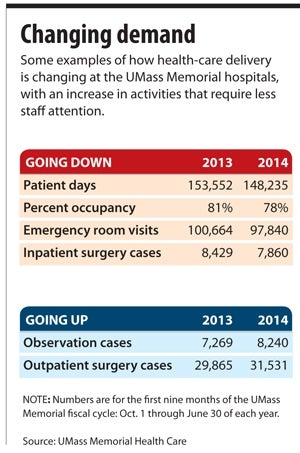The financial challenges faced by UMass Memorial Health Care have been no secret. As the region’s largest employer, UMass has about 13,000 people on its payroll, annual revenues top $2.2 billion, and it’s the parent of four hospitals throughout the region with about 1,000 beds. That’s why when UMass Memorial catches a cold, the region sneezes.
So, for the organization, the pressing question has been: Was last year’s $55-million annual operating loss merely a blip? Or a harbinger of deeper challenges at this huge – and hugely significant – nonprofit employer.
So far, the signs are optimistic that the changes UMass Memorial has been making in its operations are paying off. While it continued to lose money through the first half of this fiscal year (which ends Sept. 30), losses were cut to about $16.5 million.
But in a report on its third-quarter performance (April through June), the organization said it finished in the black, posting a healthy operating surplus of $26.9 million, helped in part by the sale of part of its ownership stake in Fairlawn Rehabilitation Hospital. That didn’t come without some pain though. Nearly 400 full time-equivalent jobs were cut, costing UMass Memorial more than $3 million in associated charges during the third quarter, and its credit rating outlook by Standard & Poor’s was lowered in June from stable to negative. To prevent the system from falling further, S&P said UMass Memorial must post break-even operating results in 2014 and move toward a sustainable operating surplus.
“What we saw happen to us is about the future of health care,” CEO Eric Dickson told us earlier this month. He cited the shift of patient care away from hospitals and into homes, more “minimally invasive” surgeries and a shift toward technology-enabled “remote consultations” between doctors and patients, all of which lower the demand on hospitals and, by extension, negatively impact revenue.
“I think we’re just scratching the surface on the impact of technology and remote visits on the future of medicine,” Dickson said.
The employees have helped, too, as “thousands” of their ideas have been implemented, which have “allowed us to make the difficult right-sizing decisions” while keeping the staff engaged, he said, some of which is done through his blog, Everyday Innovators.
The third-quarter numbers were indeed promising for UMass Memorial Health Care. If those results continue to improve, the organization and the region will be better off. As any corporate leader would know, it’s a tall order to turn around an aircraft carrier. And with 13,000 employees, UMass Memorial is a huge, complicated organization.
However, Dickson and his team have shown encouraging progress, and clearly getting out in front of the health care evolution will make a lot more sense than reacting to or resisting the innovation that’s needed to thrive. Tapping the creativity and ideas from a very big organization in an efficient manner is a daunting task, but if UMass Memorial is able to continue that momentum, and, in turn, drive better performance, it will be well on the way to stability, and a better credit rating.

